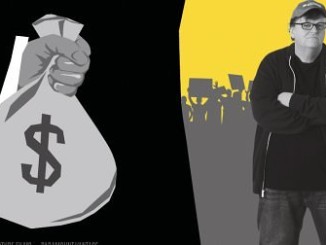 Bowling For Columbine is a film that going to infuriate some and validate others. But that’s what documentarian Michael Moore is best at- exploring hot topics that may not have easy answers.
Bowling For Columbine is a film that going to infuriate some and validate others. But that’s what documentarian Michael Moore is best at- exploring hot topics that may not have easy answers.
This is Moore’s most ambitious and accomplished film to date. What began as a film exploring how could an incident like the April 20, 1999 shooting at Columbine High School in Littleton, Colorado has grown into something so much more. From a Michigan bank giving out a free rifle for opening an account to the town of Virgin, Utah where all citizens are legally required to own a gun, Moore crosses the country asking some powerful questions, the most potent being what is America’s seeming obsession with guns.
This is not an easy film to watch. There are two montages- one of gun violence and the other showing various United States foreign policy decisions that have lead to violence- that are graphic in nature and make a formidable impression. Another section features security camera footage from Columbine High School showing teenagers fleeing the school while the two shooters stalk through the hallways.
As for what set off the two troubled teens that April morning, who can say? Was it the fact that their high school was “Home of the Rebels” and their mascot carried a flintlock rifle? Was it the hard rock music like Marilyn Manson’s that they listened to? Was it the fact that the two had gone bowling that morning?
 Matt Stone, co-creator of South Park and a Columbine High graduate, speculates to Moore that perhaps the kids snapped due to all the pressure that is put on high school students to succeed at all costs.
Matt Stone, co-creator of South Park and a Columbine High graduate, speculates to Moore that perhaps the kids snapped due to all the pressure that is put on high school students to succeed at all costs.
Moore also talks to Marilyn Manson, who makes one of the most intelligent points in the whole film. When asked what he would say to the two shooters if he had a chance to talk to them before the tragedy.
“I wouldn’t say a single word,” Manson answered. “I would listen to what they had to say which is what no one did.”
In the end, Moore presents many possibilities but makes no definite conclusions as to what is the root of our seeming national obsession with guns and predilection towards violence. Perhaps he is suggesting that there is no one right answer, but many factors that have come together to create the time we live in.




